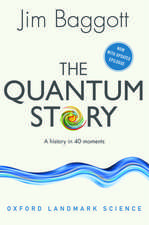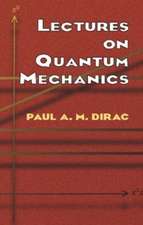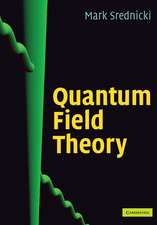Group Representation for Quantum Theory
Autor Masahito Hayashien Limba Engleză Hardback – 28 noi 2016
To describe a big picture of application of representation theory to quantum theory, the book needs to contain the following six topics, permutation group, SU(2) and SU(d), Heisenberg representation, squeezing operation, Discrete Heisenberg representation, and the relation with Fourier transform from a unified viewpoint by including projective representation. Unfortunately, although there are so many good mathematical books for a part of six topics, no book contains all of these topics because they are too segmentalized. Further, some of them are written in an abstract way in mathematical style and, often, thematerials are too segmented. At least, the notation is not familiar to people working with quantum theory. Others are good elementary books, but do not deal with topics related to quantum theory. In particular, such elementary books do not cover projective representation, which is more important in quantum theory. On the other hand, there are several books for physicists. However, these books are too simple and lack the detailed discussion. Hence, they are not useful for advanced study even in physics.
To resolve this issue, this book starts with the basic mathematics for quantum theory. Then, it introduces the basics of group representation and discusses the case of the finite groups, the symmetric group, e.g. Next, this book discusses Lie group and Lie algebra. This part starts with the basics knowledge, and proceeds to the special groups, e.g., SU(2), SU(1,1), and SU(d). After the special groups, it explains concrete applications to physical systems, e.g., angular momentum, hydrogen-type Hamiltonian, spin-orbit interaction, and quark model. Then, it proceeds to the general theory for Lie group and Lie algebra. Using this knowledge, this book explains the Bosonic system, which has the symmetries of Heisenberg group and the squeezing symmetry by SL(2,R) and Sp(2n,R). Finally, as the discrete version, this book treats the discrete Heisenberg representation which is related to quantum error correction. To enhance readers' undersnding, this book contains 54 figures, 23 tables, and 111 exercises with solutions.
| Toate formatele și edițiile | Preț | Express |
|---|---|---|
| Paperback (1) | 947.85 lei 6-8 săpt. | |
| Springer International Publishing – 9 sep 2018 | 947.85 lei 6-8 săpt. | |
| Hardback (1) | 953.97 lei 6-8 săpt. | |
| Springer International Publishing – 28 noi 2016 | 953.97 lei 6-8 săpt. |
Preț: 953.97 lei
Preț vechi: 1163.38 lei
-18% Nou
Puncte Express: 1431
Preț estimativ în valută:
182.58€ • 189.88$ • 152.78£
182.58€ • 189.88$ • 152.78£
Carte tipărită la comandă
Livrare economică 14-28 martie
Preluare comenzi: 021 569.72.76
Specificații
ISBN-13: 9783319449043
ISBN-10: 3319449044
Pagini: 370
Ilustrații: XXVIII, 338 p. 54 illus., 1 illus. in color.
Dimensiuni: 155 x 235 x 21 mm
Greutate: 0.69 kg
Ediția:1st ed. 2017
Editura: Springer International Publishing
Colecția Springer
Locul publicării:Cham, Switzerland
ISBN-10: 3319449044
Pagini: 370
Ilustrații: XXVIII, 338 p. 54 illus., 1 illus. in color.
Dimensiuni: 155 x 235 x 21 mm
Greutate: 0.69 kg
Ediția:1st ed. 2017
Editura: Springer International Publishing
Colecția Springer
Locul publicării:Cham, Switzerland
Cuprins
Foundation of Quantum Theory.- Group Representation.- Representations of Lie Group and Lie Algebra (Basics).- Representations of Lie Group and Lie Algebra (Special Case).- Representations of Lie Group and Lie Algebra (General Case).- Bosonic System.- Discretization of Bosonic System.
Recenzii
“The book is well organized. Crucial notions such as highest weight representations or coherent states are introduced, first in special cases and then generalized step by step. … There is also a quite useful index of notation in the form of 8 tablets, each table grouping symbols of a given type. The presentation of representation theory of compact groups and the Heisenberg group is quite good.” (Wojciech Lisiecki, Mathematical Reviews, March, 2018)
Notă biografică
Masahito Hayashi was born in Japan in 1971. He received the B.S. degree from the Faculty of Sciences in Kyoto University, Japan, in 1994 and the M.S. and Ph.D. degrees in Mathematics from Kyoto University, Japan, in 1996 and 1999, respectively.
He worked in Kyoto University as a Research Fellow of the Japan Society of the Promotion of Science (JSPS) from 1998 to 2000, and worked in the Laboratory for Mathematical Neuroscience, Brain Science Institute, RIKEN from 2000 to 2003, and worked in ERATO Quantum Computation and Information Project, Japan Science and Technology Agency (JST) as the Research Head from 2000 to 2006. He also worked in the Superrobust Computation Project Information Science and Technology Strategic Core (21st Century COE by MEXT) Graduate School of Information Science and Technology, The University of Tokyo as Adjunct Associate Professor from 2004 to 2007. He worked in the Graduate School of Information Sciences, Tohoku University as Associate Professor from2007 to 2012. In 2012, he joined the Graduate School of Mathematics, Nagoya University as Professor. He also worked in Centre for Quantum Technologies, National University of Singapore as Visiting Research Associate Professor from 2009 to 2012 and as Visiting Research Professor from 2012 to now. In 2011, he received the Information Theory Society Paper Award (2011) for Information-Spectrum Approach to Second-Order Coding Rate in Channel Coding. In 2016, he received the Japan Academy Medal from the Japan Academy and the JSPS Prize from Japan Society for the Promotion of Science.
He is a member of the Editorial Board of the International Journal of Quantum Information and International Journal On Advances in Security. His research interests include classical and quantum information theory, information-theoretic security, and classical and quantum statistical inference.
He worked in Kyoto University as a Research Fellow of the Japan Society of the Promotion of Science (JSPS) from 1998 to 2000, and worked in the Laboratory for Mathematical Neuroscience, Brain Science Institute, RIKEN from 2000 to 2003, and worked in ERATO Quantum Computation and Information Project, Japan Science and Technology Agency (JST) as the Research Head from 2000 to 2006. He also worked in the Superrobust Computation Project Information Science and Technology Strategic Core (21st Century COE by MEXT) Graduate School of Information Science and Technology, The University of Tokyo as Adjunct Associate Professor from 2004 to 2007. He worked in the Graduate School of Information Sciences, Tohoku University as Associate Professor from2007 to 2012. In 2012, he joined the Graduate School of Mathematics, Nagoya University as Professor. He also worked in Centre for Quantum Technologies, National University of Singapore as Visiting Research Associate Professor from 2009 to 2012 and as Visiting Research Professor from 2012 to now. In 2011, he received the Information Theory Society Paper Award (2011) for Information-Spectrum Approach to Second-Order Coding Rate in Channel Coding. In 2016, he received the Japan Academy Medal from the Japan Academy and the JSPS Prize from Japan Society for the Promotion of Science.
He is a member of the Editorial Board of the International Journal of Quantum Information and International Journal On Advances in Security. His research interests include classical and quantum information theory, information-theoretic security, and classical and quantum statistical inference.
Textul de pe ultima copertă
This book explains the group representation theory for quantum theory in the language of quantum theory. As is well known, group representation theory is very strong tool for quantum theory, in particular, angular momentum, hydrogen-type Hamiltonian, spin-orbit interaction, quark model, quantum optics, and quantum information processing including quantum error correction.
To describe a big picture of application of representation theory to quantum theory, the book needs to contain the following six topics, permutation group, SU(2) and SU(d), Heisenberg representation, squeezing operation, Discrete Heisenberg representation, and the relation with Fourier transform from a unified viewpoint by including projective representation. Unfortunately, although there are so many good mathematical books for a part of six topics, no book contains all of these topics because they are too segmentalized. Further, some of them are written in an abstract way in mathematical style and, often, thematerials are too segmented. At least, the notation is not familiar to people working with quantum theory. Others are good elementary books, but do not deal with topics related to quantum theory. In particular, such elementary books do not cover projective representation, which is more important in quantum theory. On the other hand, there are several books for physicists. However, these books are too simple and lack the detailed discussion. Hence, they are not useful for advanced study even in physics.
To resolve this issue, this book starts with the basic mathematics for quantum theory. Then, it introduces the basics of group representation and discusses the case of the finite groups, the symmetric group, e.g. Next, this book discusses Lie group and Lie algebra. This part starts with the basics knowledge, and proceeds to the special groups, e.g., SU(2), SU(1,1), and SU(d). After the special groups, it explains concrete applications to physical systems, e.g., angular momentum, hydrogen-type Hamiltonian, spin-orbit interaction, and quark model. Then, it proceeds to the general theory for Lie group and Lie algebra. Using this knowledge, this book explains the Bosonic system, which has the symmetries of Heisenberg group and the squeezing symmetry by SL(2,R) and Sp(2n,R). Finally, as the discrete version, this book treats the discrete Heisenberg representation which is related to quantum error correction. To enhance readers' undersnding, this book contains 54 figures, 23 tables, and 111 exercises with solutions.
To describe a big picture of application of representation theory to quantum theory, the book needs to contain the following six topics, permutation group, SU(2) and SU(d), Heisenberg representation, squeezing operation, Discrete Heisenberg representation, and the relation with Fourier transform from a unified viewpoint by including projective representation. Unfortunately, although there are so many good mathematical books for a part of six topics, no book contains all of these topics because they are too segmentalized. Further, some of them are written in an abstract way in mathematical style and, often, thematerials are too segmented. At least, the notation is not familiar to people working with quantum theory. Others are good elementary books, but do not deal with topics related to quantum theory. In particular, such elementary books do not cover projective representation, which is more important in quantum theory. On the other hand, there are several books for physicists. However, these books are too simple and lack the detailed discussion. Hence, they are not useful for advanced study even in physics.
To resolve this issue, this book starts with the basic mathematics for quantum theory. Then, it introduces the basics of group representation and discusses the case of the finite groups, the symmetric group, e.g. Next, this book discusses Lie group and Lie algebra. This part starts with the basics knowledge, and proceeds to the special groups, e.g., SU(2), SU(1,1), and SU(d). After the special groups, it explains concrete applications to physical systems, e.g., angular momentum, hydrogen-type Hamiltonian, spin-orbit interaction, and quark model. Then, it proceeds to the general theory for Lie group and Lie algebra. Using this knowledge, this book explains the Bosonic system, which has the symmetries of Heisenberg group and the squeezing symmetry by SL(2,R) and Sp(2n,R). Finally, as the discrete version, this book treats the discrete Heisenberg representation which is related to quantum error correction. To enhance readers' undersnding, this book contains 54 figures, 23 tables, and 111 exercises with solutions.
Caracteristici
Explains group representation theory for quantum theory in a didactic way Bridges the gap between quantum theory and group representation theory Well structured and physically motivated without giving up mathematical rigour Includes supplementary material: sn.pub/extras















